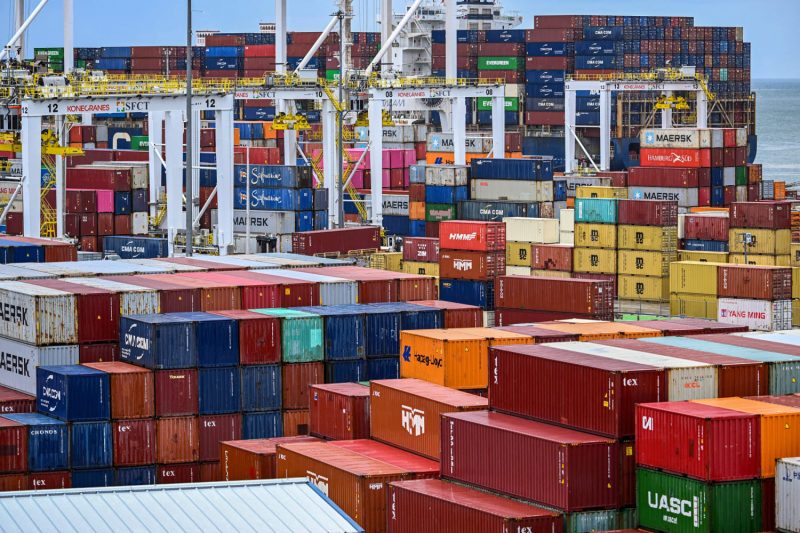Top 5 Canadian Mining Stocks This Week: Trifecta Shines with 117 Percent Gain



Statistics Canada released its second-quarter gross domestic product (GDP) figures on Friday (August 29). The data showed that the Canadian economy shrank 0.4 percent in the second quarter and declined 1.6 percent on an annualized basis. The decrease comes following first-quarter gains of 0.5 percent and a 2 percent annualized increase.
Much of the decrease was attributed to a 7.5 percent drop in exports compared to Q1. Canadian exports had risen 1.4 percent in the first three months of the year as US companies increased imports to get ahead of incoming tariffs.Excluding the lower costs at the pumps, CPI remained steady at 2.5 percent, the same increase as May and June.
On an industry level, new monthly data for June shows that the resource sector grew by 0.1 percent after two months of declines, primarily driven by a 2.6 percent gain in the oil and gas subsector, with oil sands extraction rising 6.4 percent over May. However, gains were offset by a 9.7 percent monthly decline in support activities for the resource sector, its largest drop in five years, led by reduced rigging and drilling activities.
South of the border, the US Bureau of Economic Analysis released its second estimate for Q2 real GDP on Thursday (August 28). The data shows that US GDP grew by 3.3 percent during the quarter, 0.3 percent higher than its advance estimate.
According to the agency, the figure reflects a decrease in imports and an increase in consumer spending. The GDP’s upward momentum was tempered by a 13.8 percent decrease in private domestic investment, marking the most significant decline since 2020, during the pandemic.
The growth follows a 0.5 percent decrease in the first quarter of 2025, which saw a significant rise in imports.
This week also saw US President Donald Trump attempt to remove US Federal Reserve Board of Governors member Lisa Cook. Trump justified the decision based on Federal Housing Finance Agency Director Bill Pulte’s claim that Cook claimed primary residence in two mortgage applications submitted weeks apart in 2021. She was confirmed to the Fed Board of Governors in May 2022.
Cook is fighting the move in court, with her lawyer stating that Trump’s unsubstantiated allegation of an event prior to Cook’s confirmation does not meet the ’cause’ required by the Federal Reserve Act to remove a governor. By the end of the day on Friday, the judge hearing the case did not reach a decision on whether to issue a temporary restraining order that would allow Cook to remain in her role during the case.
Pulte has previously made similar allegations against other prominent Democrats, including California Senator Adam Schiff, a vocal critic of Trump, and New York Attorney General Letitia James, who oversaw a civil suit against Trump that resulted in a US$500 million award.
Trump has been eager to reshape the Federal Reserve Board and has hinted that he would like to replace Chairman Jerome Powell before his term ends in 2026. Trump believes the Fed has not been acting quickly enough to lower interest rates and stimulate the economy.
Markets and commodities react
Canadian equity markets were largely unfazed by Canada’s weak GDP data. In fact, the S&P/TSX Composite Index (INDEXTSI:OSPTX) set a new record on Friday, closing the week up 1.73 percent to 28,564.45. The S&P/TSX Venture Composite Index (INDEXTSI:JX) did even better, climbing 5.36 percent to finish Friday at 829.57. The CSE Composite Index (CSE:CSECOMP) fell 0.45 percent on Friday following the StatsCan release, but gained 4.17 percent overall during the week to 166.9.
US equity markets also posted gains this week, but fell from record highs on Friday following a selloff of tech stocks. The S&P 500 (INDEXSP:INX) was up 1.19 percent to 6,460.25, while the Nasdaq 100 (INDEXNASDAQ:NDX) rose 0.99 percent to 23,415.42. Meanwhile, the Dow Jones Industrial Average (INDEXDJX:.DJI) gained 1.32 percent on the week to 45,631.73.
The gold price gained 3.19 percent this week on expectations of a September rate cut by the Federal Reserve, reaching US$3,448.15 per ounce by 4:00 p.m. EDT on Friday. Silver ended the week with a larger gain of 4.2 percent, nearly crossing the US$40 per ounce mark in morning trading before settling at US$39.74 per ounce.
Copper also saw some upward movement, gaining 1.1 percent to US$4.59 per pound. The S&P GSCI (INDEXSP:SPGSCI) commodities index posted an increase of 1.3 percent by close on Friday, finishing at 549.70.
Top Canadian mining stocks this week
How did mining stocks perform against this backdrop?
Take a look at this week’s five best-performing Canadian mining stocks below.
Stocks data for this article was retrieved at 4:00 p.m. EDT on Friday using TradingView’s stock screener. Only companies trading on the TSX, TSXV and CSE with market caps greater than C$10 million are included. Mineral companies within the non-energy minerals, energy minerals, process industry and producer manufacturing sectors were considered.
1. Trifecta Gold (TSXV:TG)
Weekly gain: 117.24 percent
Market cap: C$23.77 million
Share price: C$0.63
Trifecta Gold is a gold exploration company focused on a portfolio of 11 properties in the Tombstone gold belt in the Yukon, Canada.
Its most advanced is its flagship Mt. Hinton gold-silver project, located near Hecla Mining’s (NYSE:HL) Keno Hill silver mine. The company’s project page indicates that vein float samples collected in January 2023 show grades of up to 273 grams per metric ton (g/t) gold.
The company has also been advancing exploration work at its Rye property, which hosts a gold-bismuth soil anomaly, as well as several gold-rich veins.
Shares in Trifecta rose this week alongside news on Thursday that the company had commenced its inaugural drill program at Rye, completing 970 meters across three holes. The announcement reported that the first hole intersected a high density of sheeted quartz veins.
The company said preliminary rock samples collected from the site earlier in 2025 returned multiple assays with greater than 5 g/t gold, including one highlight with 21.1 g/t gold and 8,550 parts per million (ppm) bismuth.
2. Consolidated Lithium Metals (TSXV:CLM)
Weekly gain: 100 percent
Market cap: C$13.98 million
Share price: C$0.04
Consolidated Lithium is an exploration and development company working to advance a portfolio of hard rock lithium projects in Quebéc, Canada.
Its most advanced asset is the Vallée lithium project, a 75/25 joint venture between Consolidated and Sayona Mining (ASX:SAY,OTCQB:SYAXF). The project is located in the Abitibi Greenstone Belt adjacent to and along strike of Sayona’s and Piedmont Lithium (NASDAQ:PLL) North American Lithium mining operation. According to the company’s project page, the Vallée property hosts multiple lithium-bearing pegmatites over a 1 kilometer strike length.
Consolidated announced on Wednesday (August 27) that it signed a letter of intent with the Government of Quebéc-owned Soquem to earn an 80 percent interest in the Kwyjibo rare earth project, located in the Côte-Nord region of the province.
Under the terms of the letter, Consolidated can earn up to an 80 percent interest in the project through two phases, in return for a combination of cash payments, shares in Consolidated and project investments.
A 2017 preliminary economic assessment for Kwyjibo reports project economics including an after-tax net present value of C$373.9 million and an internal rate of return of 17.8 percent, with a payback period of 3.6 years.
3. Electric Metals (TSXV:EML)
Weekly gain: 68.75 percent
Market cap: C$44.34 million
Share price: C$0.27
Electric Metals is a mineral development company focused on advancing its flagship North Star manganese project in Minnesota, US. According to the company, the asset is North America’s highest-grade manganese resource. It plans to produce high-purity manganese sulphate monohydrate for lithium-ion batteries.
The most recent news from Electric Metals was released on Tuesday, when it announced a preliminary economic assessment for the project. The assessment demonstrated a base-case after-tax net present value of US$1.39 billion, with an internal rate of return of 43.5 percent and a payback period of 23 months. and suggested an average annual after-tax cash flow of US$249.6 million.
The report also included an updated mineral resource estimate with an indicated resource of 7.6 million metric tons of ore grading 19.07 percent manganese, 22.33 percent iron and 30.94 percent silicon, and an inferred resource of 3.73 million metric tons of ore grading 17.04 percent manganese, 19.04 percent iron and 30.03 percent silicon.
4. Sage Potash (TSXV:SAGE)
Weekly gain: 58.33 percent
Market cap: C$31.93 million
Share price: C$0.38
Sage Potash is a potash exploration company currently working to advance its portfolio of mineral holdings in Utah’s Paradox Basin in the US.
Historic oil and gas exploration in the basin dating back a century discovered the potential for the potash beds, but they were too deep for mining methods at the time. Sage has since confirmed their presence through its own exploration.
In a revised technical report from February 2023, the company reported an inferred mineral resource estimate of up to 159.3 million metric tons of in-place sylvinite from the upper potash bed and up to 120.2 million metric tons of sylvinite from the lower potash bed.
On August 14, Sage announced that Stockwell Day had joined the company board. Day served several ministerial roles for the Canadian government under Prime Minister Stephen Harper, including as President of the Treasury Board and Minister of International Trade.
This was followed by news on Wednesday that Day had been granted 600,000 stock options at an exercise price of C$0.30 per share and would remain valid for a period of five years.
Sage’s share price spiked earlier this week after the US Government added potash in its draft of an updated list of critical minerals.
5. Kincora Copper (TSXV:KCC)
Weekly gain: 58.33 percent
Market cap: C$24.8 million
Share price: C$0.095
Kincora Copper is an exploration company operating under a project generator model and partnering with other companies to advance its portfolio, including copper-gold projects in the Macquarie Arc of New South Wales, Australia.
Among them is the Northern Junee-Narromine Belt (NJNB) land package, which is covered by a May 2024 earn-in agreement that could see AngloGold Ashanti (NYSE:AU,JSE:ANG) earn up to an 80 percent interest in the Nyngan and Nevertire licenses through AU$50 million in exploration expenditures or AU$25 million for exploration and the completion of a pre-feasibility study.
Kincora secured a second agreement with AngloGold Ashanti in April for the Nyngan South, Nevertire South and Mulla licenses with similar terms, bringing the total exploration funding to AU$100 million.
On Monday (August 25), Kincora announced results from the first drilling program at the Nyngan project, noting that assays support the potential for porphyry copper and epithermal gold, and that it saw ‘encouraging results at particularly shallow depths’ from drill targets identified by a ground gravity survey earlier this year.
Additionally, Kincora said that drilling is ongoing at the Nevertire South and Nevertire projects, with the initial program planned for seven holes and 2,150 meters.
FAQs for Canadian mining stocks
What is the difference between the TSX and TSXV?
The TSX, or Toronto Stock Exchange, is used by senior companies with larger market caps, and the TSXV, or TSX Venture Exchange, is used by smaller-cap companies. Companies listed on the TSXV can graduate to the senior exchange.
How many mining companies are listed on the TSX and TSXV?
As of May 2025, there were 1,565 companies listed on the TSXV, 910 of which were mining companies. Comparatively, the TSX was home to 1,899 companies, with 181 of those being mining companies.
Together, the TSX and TSXV host around 40 percent of the world’s public mining companies.
How much does it cost to list on the TSXV?
There are a variety of different fees that companies must pay to list on the TSXV, and according to the exchange, they can vary based on the transaction’s nature and complexity. The listing fee alone will most likely cost between C$10,000 to C$70,000. Accounting and auditing fees could rack up between C$25,000 and C$100,000, while legal fees are expected to be over C$75,000 and an underwriters’ commission may hit up to 12 percent.
The exchange lists a handful of other fees and expenses companies can expect, including but not limited to security commission and transfer agency fees, investor relations costs and director and officer liability insurance.
These are all just for the initial listing, of course. There are ongoing expenses once companies are trading, such as sustaining fees and additional listing fees, plus the costs associated with filing regular reports.
How do you trade on the TSXV?
Investors can trade on the TSXV the way they would trade stocks on any exchange. This means they can use a stock broker or an individual investment account to buy and sell shares of TSXV-listed companies during the exchange’s trading hours.
Article by Dean Belder; FAQs by Lauren Kelly.
Securities Disclosure: I, Dean Belder, hold no direct investment interest in any company mentioned in this article.
Securities Disclosure: I, Lauren Kelly, hold no direct investment interest in any company mentioned in this article.



